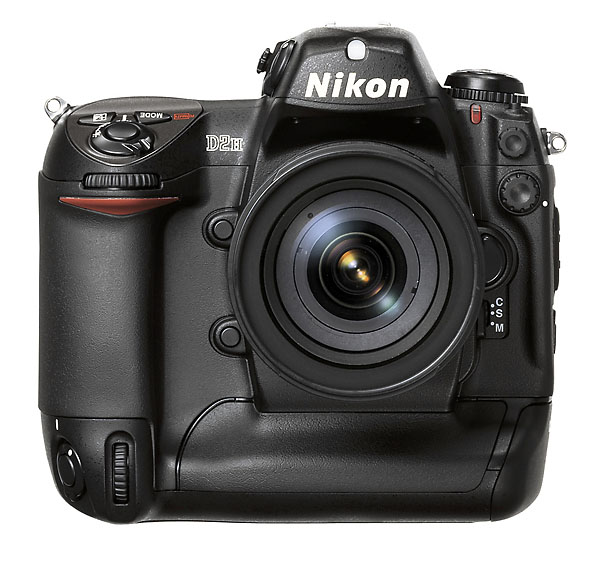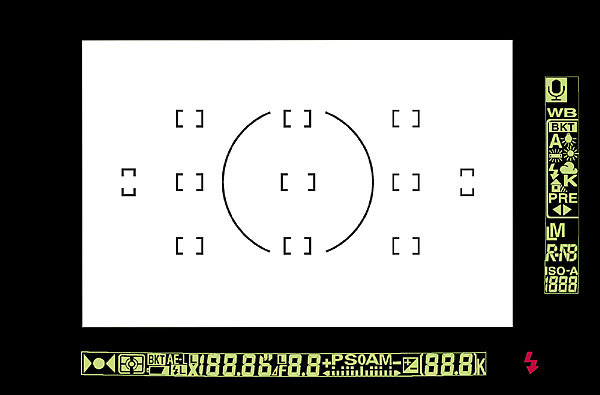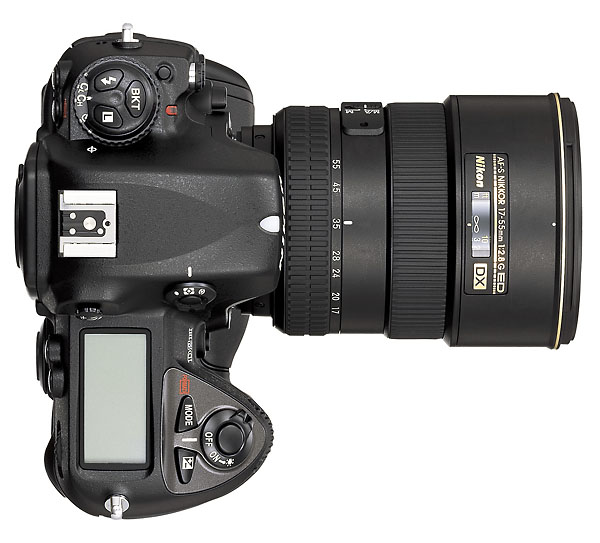 |
|
Nikon D2H: Sleek external appearance and a third eye atop the prism to set it apart from the crowd |
| Nikon D2H Digital Camera Reviewed | |
| by Bjørn Rørslett | |
2.
Appearance and Handling
The appearance of D2H draws on a familiar similarity with its predecessors in the D1-series. However, upon closer examination it becomes evident that a great deal of attention has been paid to improvements in the way the camera feels and handles. Additional controls are added to the camera, buttons are bigger or better designed, the hand grip is much steadier, and so on ad nauseum. Nikon D2H emerges as a truly professional calibre camera, ready to take on whatever challenge the photographer may expose it to.
 |
|
Nikon D2H: Sleek external appearance and a third eye atop the prism to set it apart from the crowd |
Its 4.1 MPix sensor might seem to be a little on the skimpy side, but pixel counting isn't everything and I have had plenty of double-page spreads from my D1 or D1H already, even with their "mere" 2.7 MPix CCD. Thus, I initially had no big fears as to image quality, and later on as the story unfolds, you can see for yourself whether or not I stand corrected in this presumption.
Compared to its predecessor, D1H, the most striking differences are the smaller and neater shape of the camera, less heft, a new battery now using Li-Ion technology, and the hugely improved viewfinder. Not only is the viewfinder magnification increased significantly, but the view is much brighter, and there are plethora of additional information presented in the finder as well. Whether or not you are thrilled by a 8 fps shooting rate for up to 40 jpgs (25 NEFs) is for each user to decide, but the camera certainly can deliver if you need true machine-gunning performance. The shutter is redesigned from the D1-series models and now shares vital components with the time-tested F5 shutter unit. The relationship to F5 is evident when you hear the swift, well-dampened clunk as the shutter opens and closes, the sound of which stems from the tungsten-made counterweight of the mirror.
In use, the camera handled with utmost ease and the location of most controls felt very "correct" and enabled a relaxed, highly intuitive operation of the camera and all its features. Thanks to the extremely fast shutter release lag, a mere 37 millisecs, you can indeed capture the peak of the action. Viewfinder blackout is just 80 millisecs so there is no perceivable blackening-out of the image at all, although you do get a slightly flickering impression at 8 fbps (not entirely unexpected).
Data transfer is over a USB2.0 port, safely but - in my opinion - not conveniently placed on the camera's left hand side. Nikon officials stated that the decision to replace Firewire connectivity with USB had been based upon the much wider frequency of USB-enabled computers and laptops. On an old PC/Mac, the connection falls back to USB1.x to ensure full backwards compatibility. I'd rather prefer FireWire to USB of any kind, but realize my voice isn't heard here. And I still can transfer images using my CF-cards of course. Since D2H is FAT32-aware, I believe there is no practical upper limit to the size of the cards you can deploy with it.
The ports for connection of mains and video have also been moved to the left side, how very inconvenient and a real pity compared to the D1-models. The relocation of the ports means I have to redesign my "L" bracket for the D2-series, and I won't be able to get equally solid support when the camera is mounted for taking vertical shots. Rats. Fortunately, the PC flash outlet and the remote control connector still are found in front, at their usual positions.
Gadgetry is of course taken to the next level with the D2H supporting wireless image transmission, but thankfully this feature is an add-on and not incorporated in the body itself. I cannot see myself using FTP data transfer to my car if I ever venture more than 100 meters away from it, but realise a lot of sport photographers covering big events could fall head over heels in love with this gadget.
Below is what the viewfinder looks like. Lots of information to be processed by the user for sure, but in practice the layout looks very uncluttered and informative as well. The overview is enhanced not only by increased magnification (0.86x compared to 0.8x of D1X/H), but also a slightly reduced eye-point position so you get a wider view. All digits and numerals in the finder were very easy to read and stray light into the finder well controlled.
 |
|
The viewfinder of Nikon D2H projects a very clear and bright image, and despite all information displayed, never feels too cluttered (at least for my taste). People needing AF can get all their needs satisfied from the highly capable AF system of D2H, driven by the 11 AF sensor regions distributed nearly all over the image area. Sensors can be selected, deselected, or grouped to give an optimalised personal configuration of the camera (I for one switch all these things off, but then I'm rather old-fashioned here). |
The focusing speed with my AFS lenses is thanks to the improved AF sensor technology of D2H extremely fast and responsive. Focusing tracking performed as it should, according to my brief test shootings (this is not a feature I normally use, though). Of course all the trendy new AFS and VR technologies are supported by D2H.
You can see the very sensible arrangements of the 11 AF spots which are distributed over the entire frame. Thankfully, you can group, regroup, or even switch off most of the AF areas. The degree of user configurable control of the AF system is amazing and ensures anyone can get the AF system to provide the maximum benefit and focus assistance.
The conspicuous "eye" atop the finder head makes the D2H look a bit different from its D1-series comrades. The idea behind this external sensor is to get additional data to make colour balancing better and more fail-safe when the camera is run in auto W/B mode. In particular, Nikon claims that flickering lighting such as fluorescent tubes should be no real problem with their new system. My experience shows this claim does have some validity, but still some situations are too difficult to cope with even for this clever design. Moreover, albeit the instruction manual states otherwise, auto W/B does not work well with manual lenses even if they do activate the camara's matrix metering.
Support for GPS, a very nice feature of D1X and D1H, has quite unexpectedly been removed from D2H. I cannot understand why, after all GPS only needed a small serial port and a few bits of circuitry inside to record the data into the EXIF header of the image files. As a replacement, surely to hearten any gadgetry freak, we now have a voice-recording feature on the D2H. You record by pressing a small "mic" button and talk into a tiny hole on the rear. Sound quality clearly isn't exactly up to hi-fi standards, but the system works inobtrusively and reliably as well, and you can even listen to your own distorted voice emanating from the camera (run though a better sound system, the quality isn't really that bad, though). You can record up to 60 seconds of sound into a .WAV file, which will accompany your image file(s). The .WAV file gets the same sequence number as the .JPG /.NEF file(s) and its presence is duly noted in the EXIF header, too.
 |
|
The difference in the external design of D2H to the D1-series may not seem that big, but all the details and buttons have been improved, and the protruding lip of the battery compartment means the hand-grip is much better. |
Several improvements may not be the ones hitting the front pages, but they are important for the end user nevertheless. The relase button for switching lenses is now much bigger and easier to use, even when you wear thick gloves (remember I'm a Norwegian and we endure, or try to endure, our cold winters). The eyepiece is secured with a locking catch and you are no longer going to have to replace them every month or so. Although the eyepiece (DK-17) is new, you can still use the nice DK-2 rubber eyecups with it. The command wheels front and rear are duplicated to give better control of the camera used for shooting verticals, a nice touch. The AF-ON button for verticals now is as big as the one for horizontals, a small but welcome improvement form the D1-series.
The LCD monitor on the rear is much bigger and brighter than before, and the menu system is remarkably improved both in terms of ease of use and of more logical manoeuverability. The hood covering the LCD is very clear and transparent, and stays resonably (but not perfectly) well in place. It will scratch easily and I wonder how long its transparency is going to last. To remove it you press in the sides and lift it out. Unfortunately, the design is open on the sides and this means your breath will condense inside it on a cold day. A small rubber gasket, fitted under the left side of the hood, settles this issue, and gives me the pleasure of improving an improved design as well. Being a left-handed person, I often lift my cameras using my left hand, and this was much easier with the old D1-series than with D2H. This results because the LCD now is moved into a central position and offers less grip than before. Oh well, I guess I can live such small inconveniences down.
Digital flash technology has long been a source of frustration for the end users: no problem when everything works, lots of grievance when you're left in the literal darkness or the entire energy load of your batteries make a giant pop - and that's it. I'm happy to report that D2H behaved very civilised with my SB28DX flash (no, I won't buy more modern units, flash for me has been on the wane for a long time). No surprises in any direction, provided I dial in a +1 EV correction to the exposure. On default settings, D2H files with flash were a tad underexposed to my liking. All flash modes, front or rear curtain sync, worked perfectly (with +1 EV added).
Nikon improved the battery system of D2H by switching to Li-Ion technology with the EN-EL4 batteries, thus these are not backwards compatible with the D1-series. Neither are the new battery charger (MH-21) or mains supply (EH-6). Evidently there is no upper limit to the diversity and multitude of auxiliary paraphenalia I'm going to have to bring with me for future digital sessions in the field.
Battery performance of my D2H has been quite good, although not outstanding, and I get around 200 shots per charge. This includes a lot of image monitoring and checking on the LCD screen, and I'd like to add that outdoors temperatures have hovered around 0°C during most of the shooting. I expect better performance when the ambient temperature becomes more pleasant. I note other people claim they're getting a much higher number of shots per charge, good for them of course, but with my way of shooting, and in the ambient temperature I'm living (not thriving), about 200 shots are all I'll get.
I've encountered very few operational bugs with my D2H. The issue with erratic W/B in conjunction with manual lenses is just annoying and not a major one. The same can be said for the intermittent and very rare misrecording of the shooting date in the EXIF header, which I've seen just happening once or twice in several thousands shots. I'd like to add the LCD hood to the bug list as well, but not every one will concede to my whims in this respect. The need to increase exposure for flash +1 EV can possibly be considered a bug as well.
The final, and to me most remarkable, improvement of D2H is its ingenious backwards compatibility with older, manual-focusing (MF) lenses. For years now, commencing with the introduction of F5 in 1996, Nikon has crippled the metering compatibility even of the pro-level cameras. Many long-term Nikon aficionados take exception to this practice and some, myself included, have had CPU modifications done to older lenses to make them more amenable with newer cameras. With the introduction of D2H, I feel our voices have been listened to. Any AI'd, AI, or AIS Nikkor not needing the reflex mirror to be swung aside can be mounted on the D2H. I have literally hundreds of lenses fulfilling that score, eureka! Using the nifty function button (lower front left, below the preview control), it's simplicity itself to give the camera needed details about lens speed and focal length. You can dial in the data for all your MF lenses, and the camera will recall the maximum aperture if you rotate the dial to get focal length. If you have several lenses with the same focal length, you do have to select amongst them, but most people won't even notice this. In practice the setting of the data only takes a fraction of a second, and best of all, the D2H remembers the data for the MF lens last used, so when you swap a single MF lens with AF/AFS Nikkors in a shooting session, there is no need to repeat the setup of the manual lens. Very, very clever. Very, very nice.
Nikon has not gone the entire possible way with the MF compatibility, however, because you cannot use exposure modes other than "A" or "M" with them, but matrix metering will work. Since setting the actual aperture of any Nikkor can done from the camera, as long as the camera identifies the lens in use, I was in the beginning a little surprised that "P" or "S" modes wouldn't work (not that I would fall into the trap of using these "exposure for dummies"-modes, of course). My analysis is that Nikon could implement the feature if they wanted, but refrained from doing so as not to run into trouble with inaccurate exposure if an AI'd or AI lens was used. These lenses have non-linear response to stopping down the aperture, and you should always set the aperture directly on the lens, not with the camera's controls. Saved by the bell as it were, Nikon to the user's rescue.